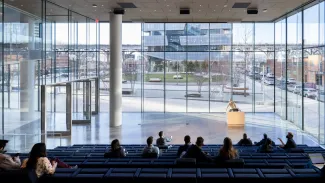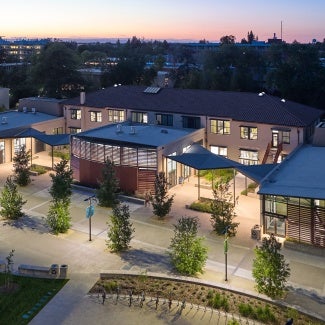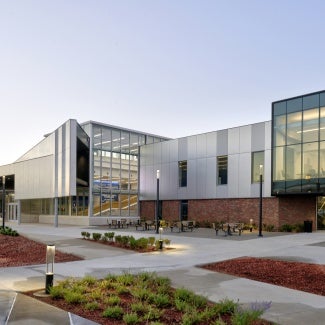Columbia Business School
The award-winning school design of Columbia Business School in New York doubles the school’s existing square footage while providing a compelling space for the diverse and innovative exchange of ideas.

Project highlights: Columbia Business School
- Architecture firm: Diller Scofidio + Renfro, in collaboration with FXCollaborative
- Owner: Columbia Business School
- Location: New York
- Category: Merit
- Project site: Previously developed
- Building program type(s): Education - college/university (campus-level)
With two distinct buildings that share a common DNA, this new home for Columbia Business School in New York’s West Harlem neighborhood has doubled the school’s existing square footage while providing a compelling space for students, faculty, and alumni to exchange ideas. Both buildings set the stage for dynamic interactions among the university’s different populations by shuffling faculty and student floors, an intention that’s legible in their syncopated silhouettes.
The team’s design reinforces the notion that creativity and innovation, typically experienced in more informal environments, are as important to a business school education as the qualitative skills developed in classroom settings. In both the 11-story Henry R. Kravis Hall and the eight-story David Geffen Hall, intersecting vertical networks of circulation and collaborative learning environments connect to teaching, social, and study spaces to foster learning and interaction 24 hours a day. Stairs wind through both buildings to form a dialogue that stretches across The Square, a 40,000-square-foot public park linking them, animating the facades with the rhythms of daily activity.
In anticipation of future needs for distance learning and connectivity, the team ensured the classrooms can expand to augment in-person learning and make education more accessible. In the classrooms, every person’s face can be captured on camera and projected onto other spaces with writing and image surfaces. More projectors can be easily added, and a stereophonic audio system picks up all voices in the classroom.
Continuous engagement with the city is a critical element of both buildings’ design. Kravis Hall boasts 360 degrees of exposure and proximity to the Hudson River, while Geffen Hall solidifies a connection to the neighborhood’s fabric. The Square and numerous retail spaces draw the community in, and the Columbia-Harlem Small Business Development Center advances the school's decade-long history of supporting local entrepreneurs.
A master plan envisioned by Renzo Piano mandates that the ground floors of each building on Columbia’s Manhattanville campus provide a porous connection to the city beyond. Both of the LEED Gold-certified business school buildings meet the ground with social and event spaces that establish visual and programmatic connections across The Square. At Kravis Hall, the Samberg Commons is an urban-scale living room for the university community replete with undulating seating that accommodates group study or a place for lunch. Geffen Hall’s Cooperman Commons welcomes 274 people to its auditorium space and hosts student orientations and faculty meetings.
Framework for Design Excellence measures
Was there a design charrette? Yes
Level of community engagement:
Consult: Stakeholders were provided with opportunities to provide input at pre-designed points in the process.
Site area that supported vegetation (landscape or green roof) pre-development: Not applicable
Site area that supports vegetation post-development: 50%
Site area covered by native plants supporting native or migratory species and pollinators: 30%
Strategies used to promote Design for Ecosystems: Bird Safety
Is potable water used for irrigation? Yes
Is potable water used for cooling? Yes
Is grey/blackwater reused on-site? No
Is rainwater collected on-site? Unknown
Stormwater managed on-site: 100%
2030 Commitment baseline EUI: 120 kBtu/sf/yr
Predicted net EUI including on-site renewables: 90 kBtu/sf/yr
Reduction from the benchmark: 33%
Is the project all-electric? No
Level of air filters installed: MERV 12-14
Was a “chemicals of concern” list used to inform material selection? No
Do greater than 90% of occupied spaces have a direct view to the outdoors? Yes
Were embodied carbon emissions estimated for this project? No
Estimated service life: 100 years
Floor area, if any, representing adapting existing buildings: 0%
Ability to survive without utility power: Partial back-up power
Risk assessment and resilience services provided: Hazard identification, Climate change risk, Building vulnerability assessment, Hazard mitigation strategies above code
Has a post-occupancy evaluation been conducted? No, but a POE will be conducted
Building performance transparency steps taken:
Present the design, outcomes, and/or lessons learned to the office.
Present the design, outcomes, and/or lessons learned to the profession.
Present the design, outcomes, and/or lessons learned to the public.
Publish lessons learned from design, construction, and/or occupancy.
Project team & Jury
Year of substantial project completion: 2022
Gross conditioned floor area: 492,000 sq. ft.
Architect: Diller Scofidio + Renfro
Architect, Sustainability/LEED consultant: FXCollaborative
Structural Engineer, Exterior Envelope and Façade
Consultant: Arup
Associate Architect (Dedicated Dining, Multi-Function Room): Aaris Design Studios
Mechanical Engineer: Buro Happold
Construction Manager: Turner Construction
Lighting Design: Tillotson Design Associates
Acoustics: Cerami & Associates Vertical Transportation: Van Deusen and Associates
Civil Engineering: Stantec
Consultants AV: Cerami & Associates, The Clarient Group, Jaffe Holden
IT: The Clarient Group, Jaros Baum & Bolles
Security: DVS Security Consulting and Engineering
Food Services: Romano Gatland
Cost Consulting: Dharam Consulting
Code: Milrose
Graphics and Wayfinding: Pentagram
Lori Cappucio, AIA (Chair), SmithGroup, Washington, DC
Omar Bailey, AIA, Shepley Finch, Phoenix
Vince Gonzales, AIA, Seattle Public Schools, Seattle
Kandis Larsen, AIA, Integrus + YGH, Spokane, Wash.
Sindu Meier, AIA, William Rawn Associates, Milton, Mass.
The Education Facility Design Award recognizes state-of-the-art education environments being developed in today's learning spaces.
Thirteen projects showcase the best in today's learning spaces.













